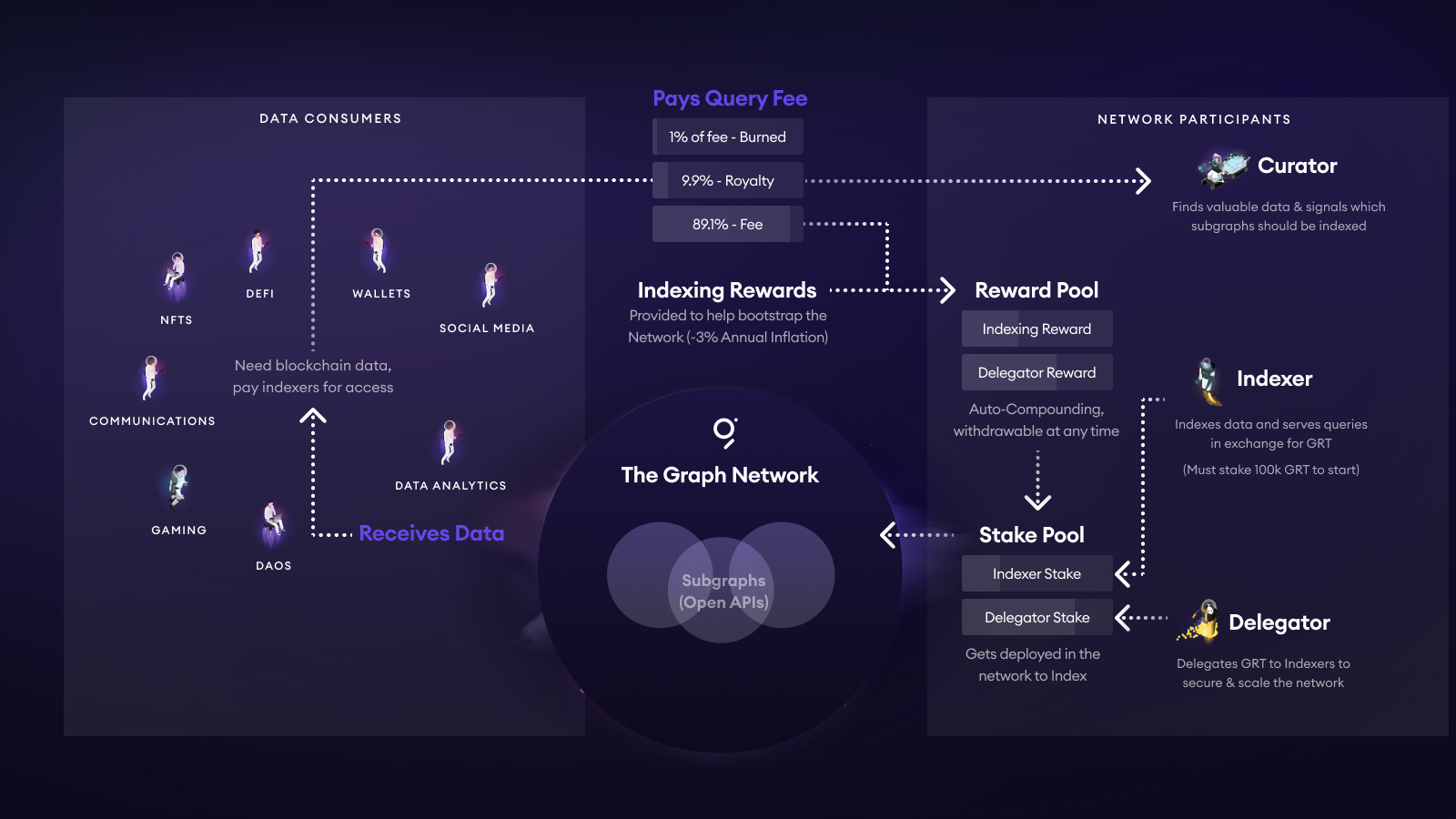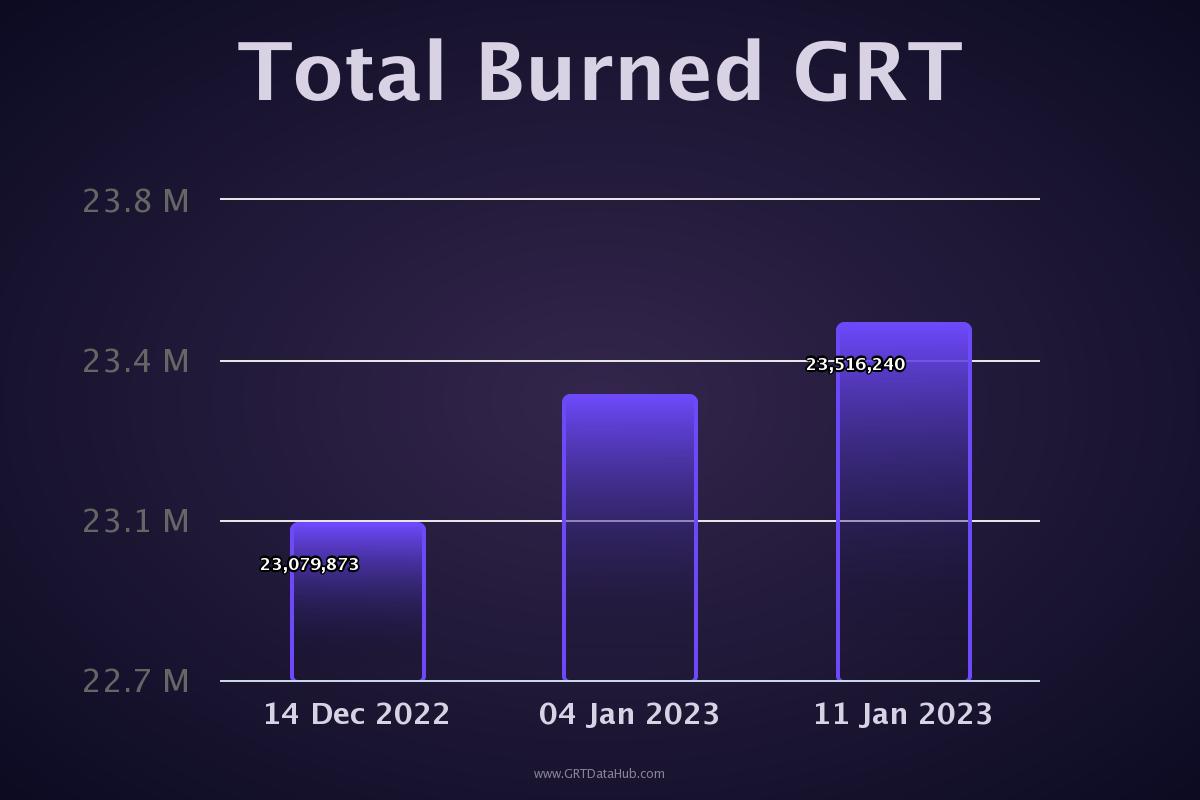7 minutes
Les tokenomiques du réseau The Graph
Aperçu
The Graph is a decentralized protocol that enables easy access to blockchain data. It indexes blockchain data similarly to how Google indexes the web. If you’ve used a dapp that retrieves data from a Subgraph, you’ve probably interacted with The Graph. Today, thousands of popular dapps in the web3 ecosystem use The Graph.
Spécificités
Le modèle de The Graph s’apparente à un modèle B2B2C, mais il est piloté par un réseau décentralisé où les participants collaborent pour fournir des données aux utilisateurs finaux en échange de récompenses GRT. GRT est le jeton d’utilité de The Graph. Il coordonne et encourage l’interaction entre les fournisseurs de données et les consommateurs au sein du réseau.
The Graph joue un rôle essentiel en rendant les données de la blockchain plus accessibles et en soutenant une marketplace pour leur échange. Pour en savoir plus sur le modèle de facturation de The Graph, consultez ses plans gratuits et de croissance.
-
Adresse du jeton GRT sur le réseau principal : 0xc944e90c64b2c07662a292be6244bdf05cda44a7
-
Adresse du jeton GRT sur Arbitrum One : 0x9623063377AD1B27544C965cCd7342f7EA7e88C7
Les rôles des participants au réseau
Les participants au réseau sont au nombre de quatre :
-
Délégateurs - Délèguent des GRT aux Indexeurs & sécurisent le réseau
-
Curators - Find the best Subgraphs for Indexers
-
Developers - Build & query Subgraphs
-
Indexeurs - épine dorsale des données de la blockchain
Les Fishermen et les arbitres font également partie intégrante du succès du réseau grâce à d’autres contributions, soutenant le travail des autres participants principaux. Pour plus d’informations sur les rôles du réseau, lire cet article.

Délégateurs (gagnent passivement des GRT)
Indexers are delegated GRT by Delegators, increasing the Indexer’s stake in Subgraphs on the network. In return, Delegators earn a percentage of all query fees and indexing rewards from the Indexer. Each Indexer sets the cut that will be rewarded to Delegators independently, creating competition among Indexers to attract Delegators. Most Indexers offer between 9-12% annually.
Par exemple, si un Délégateur délègue 15 000 GRT à un Indexeur offrant 10 %, le Délégateur recevra environ 1 500 GRT de récompenses par an.
Une taxe de délégation de 0,5 % est prélevée chaque fois qu’un Délégateur délègue des GRT sur le réseau. Si un Délégateur choisit de retirer les GRT qu’il a délégués, il doit attendre la période de déverrouillage de 28 époques. Chaque époque compte 6 646 blocs, ce qui signifie que 28 époques représentent environ 26 jours.
Si vous lisez ceci, vous pouvez devenir Délégateur dès maintenant en vous rendant sur la page des participants au réseau, et en déléguant des GRT à un Indexeur de votre choix.
Curateurs (Gagnez des GRT)
Curators identify high-quality Subgraphs and “curate” them (i.e., signal GRT on them) to earn curation shares, which guarantee a percentage of all future query fees generated by the Subgraph. While any independent network participant can be a Curator, typically Subgraph developers are among the first Curators for their own Subgraphs because they want to ensure their Subgraph is indexed.
Subgraph developers are encouraged to curate their Subgraph with at least 3,000 GRT. However, this number may be impacted by network activity and community participation.
Curators pay a 1% curation tax when they curate a new Subgraph. This curation tax is burned, decreasing the supply of GRT.
Développeurs
Developers build and query Subgraphs to retrieve blockchain data. Since Subgraphs are open source, developers can query existing Subgraphs to load blockchain data into their dapps. Developers pay for queries they make in GRT, which is distributed to network participants.
Creating a Subgraph
Developers can create a Subgraph to index data on the blockchain. Subgraphs are instructions for Indexers about which data should be served to consumers.
Once developers have built and tested their Subgraph, they can publish their Subgraph on The Graph’s decentralized network.
Querying an existing Subgraph
Once a Subgraph is published to The Graph’s decentralized network, anyone can create an API key, add GRT to their billing balance, and query the Subgraph.
Les subgraph sont interrogés à l’aide de GraphQL, et les frais d’interrogation sont payés avec des GRT dans Subgraph Studio. Les frais d’interrogation sont distribués aux participants au réseau en fonction de leur contribution au protocole.
1% des frais de requête payés au réseau sont brûlés.
Indexeurs (gagner des GRT)
Indexers are the backbone of The Graph. They operate independent hardware and software powering The Graph’s decentralized network. Indexers serve data to consumers based on instructions from Subgraphs.
Les Indexeurs peuvent gagner des récompenses en GRT de deux façons :
-
Query fees: GRT paid by developers or users for Subgraph data queries. Query fees are directly distributed to Indexers according to the exponential rebate function (see GIP here).
-
Indexing rewards: the 3% annual issuance is distributed to Indexers based on the number of Subgraphs they are indexing. These rewards incentivize Indexers to index Subgraphs, occasionally before the query fees begin, to accrue and submit Proofs of Indexing (POIs), verifying that they have indexed data accurately.
Each Subgraph is allotted a portion of the total network token issuance, based on the amount of the Subgraph’s curation signal. That amount is then rewarded to Indexers based on their allocated stake on the Subgraph.
Pour faire fonctionner un nœud d’indexation, les Indexeurs doivent staker 100 000 GRT ou plus avec le réseau. Les Indexeurs sont incités à s’approprier des GRT proportionnellement au nombre de requêtes qu’ils traitent.
Indexers can increase their GRT allocations on Subgraphs by accepting GRT delegation from Delegators, and they can accept up to 16 times their initial self-stake. If an Indexer becomes “over-delegated” (i.e., more than 16 times their initial self-stake), they will not be able to use the additional GRT from Delegators until they increase their self-stake in the network.
Le montant des récompenses reçues par un Indexeur peut varier en fonction du self-stake de l’indexeur, de la délégation acceptée, de la qualité du service et de nombreux autres facteurs.
Token Supply : Incinération & Emission
The initial token supply is 10 billion GRT, with a target of 3% new issuance annually to reward Indexers for allocating stake on Subgraphs. This means that the total supply of GRT tokens will increase by 3% each year as new tokens are issued to Indexers for their contribution to the network.
The Graph is designed with multiple burning mechanisms to offset new token issuance. Approximately 1% of the GRT supply is burned annually through various activities on the network, and this number has been increasing as network activity continues to grow. These burning activities include a 0.5% delegation tax whenever a Delegator delegates GRT to an Indexer, a 1% curation tax when Curators signal on a Subgraph, and a 1% of query fees for blockchain data.

En plus de ces activités d’incinération régulières, le jeton GRT dispose également d’un mécanisme de réduction (slashing) pour pénaliser les comportements malveillants ou irresponsables des Indexeurs. Lorsqu’un Indexeur est sanctionné, 50 % de ses récompenses d’indexation pour l’époque sont brûlées (l’autre moitié est versée au fisherman), et sa participation personnelle est réduite de 2,5 %, la moitié de ce montant étant brûlée. Les Indexeurs sont ainsi fortement incités à agir dans l’intérêt du réseau et à contribuer à sa sécurité et à sa stabilité.
Amélioration du protocole
The Graph Network est en constante évolution et des améliorations sont constamment apportées à la conception économique du protocole afin d’offrir la meilleure expérience possible à tous les participants au réseau. The Graph Council supervise les modifications du protocole et les membres de la communauté sont encouragés à y participer. Participez aux améliorations du protocole sur le Forum The Graph.